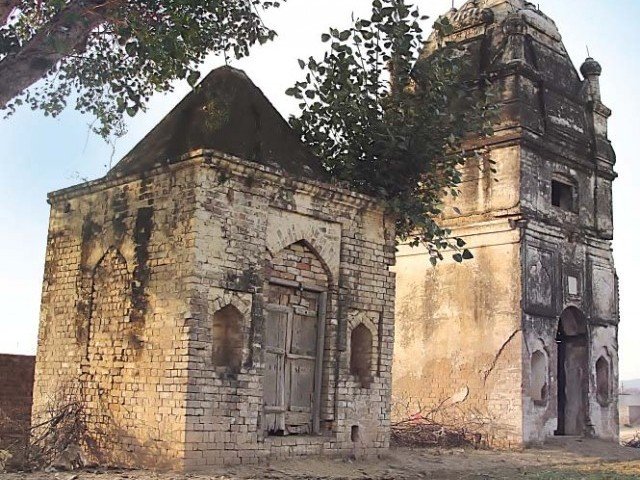 |
| PHOTO: ZULFIQAR KALHOROEastern view of the temple and Samadhi. |
Qutbal is a historical village in Fateh Jang tehsil noted for its Sikh and Hindu period buildings. It was an important trade center during the Sikh rule over Punjab and was also famous for Hindu merchants who controlled business in Fateh Jang and other towns in Attock district.
After Independence the Hindus and Sikhs migrated to India. Today the village is mainly inhabited by Khater, Mughal, Awan and other castes. The population of the village is about 5000, as confirmed by Qazi Arif, religious leader of the village.
Some of the monuments built during the Sikh and British periods still grace the landscape of Qutbal. The ban (pond) constructed of semi-masonry was used by Hindus for ritual bath with a small reserved area for women, which no longer exists.
Another building complex from that period is that of a temple, a samadhi and haveli (locally called Mari) which dominate the landscape of Qutbal village.
The temple is believed to have been built by Lakhi Devi in the memory of her father Narain Singh in 1924. The inscription slab is fixed on the façade of the temple. It is a square building. The sanctum is superimposed with a square shikhara (superstructure), different from other temples in the Potohar region, which have octagonal shikharas.
The artists of Attock have also added corner turrets to the structure which are normally found on Muslim tombs. In the temple architecture, the skhikara is always decorated with miniature shikhars or niches for placing the images (murtis). The temples found in other towns and villages of Attock district particularly at Makhad Sharif, Attock Khurd, Attock town, Hazro, Kot Fatah Khan, Fatah Jang, and Hasan Abdal do not have corner turrets or kiosks.
The corner turrets are only peculiar to the Qutbal temple. This is the innovation of the Attock artists, because the artists of the Attock were famous temple and haveli builders in the Potohar region. They built many havelis and temples in almost all four districts of Potohar.
The top of the shikhara is also decorated with a turret, not with the kalasa or amalaka as found on the shikhars. Close to the temple is a Samadhi which is also built on a square plan.
The main entrance of the Samadhi is flanked by two niches which were used for placing oil lamps. From inside it is decorated with floral designs but most of its paintings have now been damaged.
“It has now been turned into a barn,” said Gul Faraz Khatar who lives close to the Samadhi.
However, the impressive structure in Qutbal is the haveli. It is a two-storey building and decorated with fresco paintings on the inside as well as outside.
There is no such impressive haveli in the whole of Fatah Jang tehsil. One of the distinctive features of the Mari is the tower on the top of the haveli which, in Potohari havelis, is generally square or octagonal.
The havelis in Daultala and Kontrila in Gujar Khan, Khem Singh Bedi haveli in Kallar Syedan and Wah have towers for taking a panoramic view of the surroundings and enjoying the morning and evening breeze in the summers.
“The haveli was turned into government girls primary school when the owner of the building migrated to India,” said Muhammad Ramzan Mughal.
Much of the painting work is now damaged. Floral paintings on the façade of the haveli are also in a bad condition. The wooden doors of the haveli are all gone. The wood carvings found on the windows and the ceiling of the haveli are also in a bad state of preservation.
All these historical buildings are victims of neglect. Authorities should take note of the crumbling condition of the temple, Samadhi and haveli. The haveli being used as a school needs to be repaired as it is serving a purpose and is a landmark of the history of the village.
The author is Research Anthropologist at Pakistan Institute of Development Economics (PIDE), Islamabad.
He may be contacted at [email protected]
Published in The Express Tribune, February 4th, 2011.

